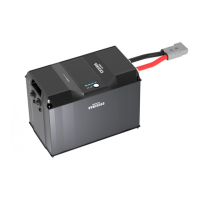— 23 —
Important Safety Information
General
z
Wear proper protective equipment and use insulated tools during installation and operation. Do not wear
jewelry or other metal objects when working on or around the inverter charger.
z
Keep the inverter charger out of the reach of children.
z
Do not dispose of the inverter charger as household waste. Comply with local, state, and federal laws and
regulations and use recycling channels as required.
z
In case of fire, put out the fire with a FM-200 or CO2 fire extinguisher.
z
If the inverter charger is installed improperly on a boat, it may cause damage to components of the boat.
Have the inverter charger by a qualified electrician.
z
Do not expose the inverter charger to flammable or harsh chemicals or vapors.
z
Clean the inverter charger regularly to ensure the cooling fans are not blocked.
z
It is recommended that all cables (except communication cables) should not exceed 10 meters (32.8 feet)
because excessively long cables result in a voltage drop. The communication cables should be shorter than
6 m (19.6 feet).
z
The cable specifications listed in the quick guide account for critical, less than 3% voltage drop and may not
account for all configurations.
Inverter Charger Safety
z
There are no serviceable parts in the inverter charger. Do not open, dismantle, repair, tamper with, or modify
the inverter charger.
z
Confirm the polarities of the devices before connection. A reverse polarity contact can result in damage to
the inverter charger and other connected devices, thus voiding the warranty.
z
Ensure the inverter charger is firmly grounded to a building, vehicle, or earth grounded. Keep the inverter
away from EMI receptors such as TVs, radios, and other audio/visual electronics to prevent damage /
interference to the equipment.
z
The inverter charger generates heat when working. To prevent burns, touch the configuration panel only
when the inverter charger is working.
z
Do not parallel the inverter charger with other AC input sources to avoid damage.
Battery Safety
z
Risk of electric shock! Ensure the connected battery is turned off before connecting it to the inverter
charger.
z
Do not use batteries if there is any damage.
z
Do not touch the exposed electrolyte or powder if the battery is damaged.
z
Risk of explosion! Never install the inverter charger in a sealed enclosure with flooded batteries! Do not
install the inverter charger in a confined area where battery gases can accumulate.
z
Prior to installing the inverter charger, ensure all battery groups are installed properly.
z
The inverter charger should be as close to the battery as possible to avoid voltage drop due to long cables.
z
Ensure the battery voltage is within the normal range (9V to 15.8V) according to its user manual. If the
battery voltage is lower than 9V, the inverter charger fails to detect the battery. If the battery voltage is
higher than 15.8V, the inverter charger is damaged.

